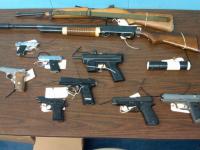-
Defining – and monitoring -- domestic terrorism in the U.S.
Domestic terrorism in the United States “is not just a function of a couple of militia related guys taking over something out West. It’s not just a bunch of white supremacist in white hoods,” says Thomas Brzozowski was appointed to lead the Justice Department’s new domestic terrorism office a year ago. In the past, a host of groups such as anarchists and the Ku Klux Klan have been under surveillance by the federal government. When the FBI was formed in the early twentieth century, communists and later anti-war activists, women’s rights organizations, and civil rights groups came to be viewed as domestic threats. Brzozowski says that today’s Justice Department is more sensitive to the free exercise of civil liberties.
-
-
Report finds strong link between strength of states’ gun laws and rates of gun violence
A new report has found a strong correlation between the strength of state gun laws and levels of gun violence. The report, which analyzes ten specific indicators of gun violence in all fifty states, found that the ten states with the weakest gun laws collectively have levels of gun violence that are more than three times higher than the ten states with the strongest gun laws. The ten states with the weakest gun laws collectively have three times more gun violence than the ten states with the strongest gun laws.
-
-
Clown threats may be unnerving, but they are not terrorism
The fear of clowns has been around for decades, perpetuated by Stephen King’s 1986 novel “It” as well as dozens of TV shows and movies. But what previously was an underlying nervousness recently has mushroomed into a more immediate threat as a result of media reports of clowns approaching or appearing to threaten children. Some have called the incidents “clown terrorism,” but a terrorism expert says that despite the growing sense of fear, it is important to avoid calling the threats and attacks acts of terrorism.
-
-
Comparing U.S. deaths from terrorism vs. gun violence
The number of Americans killed in acts of terrorism – both on U.S. soil and abroad — between 2001 and 2014 is 3,412 (including the victims of the 9/11 attacks). During the same period, 440,095 people died by firearms on U.S. soil (homicides, accidents, and suicides). In 2014, for every one American killed by an act of terrorism in the United States or abroad, 1,049 Americans died in the United States because of guns.
-
-
Seventy million more firearms added to U.S. gunstock over past twenty years

The estimated number of privately owned guns in America grew by more than seventy million — to approximately 265 million — between 1994 and 2015. Long guns, such as rifles and shotguns, make up the majority of the U.S. gunstock. But handguns represent the majority of new guns acquired over the past twenty years, making up 42 percent of the total civilian-owned gunstock in the United States, compared to one-third two decades ago.
-
-
Violence against police officers can trigger increased discrimination in police stops
A new study has found that incidents of extreme violence against police officers can lead to periods of substantially increased racial disparities in the use of force by police. The study, which used data from almost four million time- and geo-coded pedestrian stops in New York City, examined how violent acts against police officers influenced the subsequent use of force by police against racial minorities.
-
-
3 percent of U.S. gun owners own half of all privately owned firearms in U.S.
Half the guns in private hands in the United States are owned by just 3 percent of American adults, according to a new study. An estimated 7.7 million adults in the United States – a group of gun super-owners – are stockpiling between eight and 140 firearms per person. On average, these super-owners own seventeen guns each. Half of the estimated fifty-five million gun owners in America own either one or two guns.
-
-
Between 300,000 and 600,000 guns are stolen in U.S. every year – an average of 1,600 every day
Between 300,000 and 600,000 are stolen in the United States every year – for an average of more than 1,600 guns stolen every day, or more than one every minute. The number of gun deaths in the United States averages 33,000 a year, and the number of gun injuries averages 120,000 a year. The researchers note that the 1,600 guns stolen on average every day provide a weapon for each and every instance of gun violence – death or injury — in the United States each year, several times over.
-
-
NYC terrorist captured: What we know so far
Ahmad Khan Rahami, the suspect in placing two bombs in Manhattan on Saturday – one of them exploded, injuring twenty-nine people, while the other was disarmed — has been arrested in Linden, New Jersey. He was spotted by residents sleeping in a vestibule next to a bar, and they called the police. Fire was exchanged as the police closed in on him, and two policemen, and Rahami himself, were injured, but not seriously. The Rahami family’s chicken restaurant had problems city ordinances in Elizabeth, New Jersey, and in 2011 the family sued that city and its police department for discrimination and harassment.
-
-
Alabama public library threatens jail time for borrowers with overdue books
The Athens-Limestone Public Library in Athens, Alabama, has just about had enough with people who borrow books from the library and then take their time returning them. Accordingly, the library has warned people they could go to jail if they fail to return borrowed books on time.
-
-
White Nationalist groups growing much faster than ISIS on Twitter

The number of White Nationalists and self-identified Nazi sympathizers on Twiter had multiplied more than 600 percent in the last four years — outpacing ISIS in all social media aspects, from the number of follower counts to the number of daily tweets, a new study found. The study’s author notes that ISIS has gained a reputation for effectively using Twitter for propaganda and recruitment, but that White Nationalist groups have excelled even more in exploiting the medium. The report says that unlike the campaign Twitter has been conducting against ISIS, White Nationalists are continuing to use the service with “relative impunity.”
-
-
Europol deploys 200 counterterrorism officers to Greece to thwart ISIS infiltration
Rob Wainwright, the chief of Europol, the EU’s law enforcement agency, said that 200 counter terrorism officers will be deployed to the Greek islands within weeks in an effort to thwart a “strategic”-level campaign by ISIS to infiltrate terrorists into Europe. The new task force will be deployed alongside Greek border guards and use technologies developed by British security forces at Heathrow to help spot potential terrorists.
-
-
French schools to hold security drills, including mock terrorist attacks
As part of the French government’s bolstering of security measures in the wake of a series of terrorist attacks, French schools, beginning with the new school year, will now conduct three security drills a year – including at least one drill in which a mock assailants enter the school building.
-
-
Police seized drones trying to smuggle contraband into London prison
The police have seized two drones carrying drugs and mobile phones as they were making their way toward the all-male Pentonville jail in Islington, north London. Drones were increasingly being used to smuggle items into prisons in England and Wales. Figures showed there were thirty-three incidents involving devices in 2015, compared to two in 2014 and none in 2013.bDrugs, phones, mobile chargers, and USB cards were among the items discovered.
-
-
“Zombie drug” flakka causes “excited delirium,” but probably not cannibalism: Experts
It was a gruesome sight: Florida police pulled a 19-year-old Florida State University student away from the bodies of his two victims, only to find that the one of them was severely bitten in the face. Police officers say the immediately knew who (or, rather, what) the culprit was: flakka, or bath salts, a powerful man-made drug. Experts say that “bath salts” drugs can cause “excited delirium,” but probably do not drive users to cannibalism.
-
More headlines
The long view
How Male Grievance Fuels Radicalization and Extremist Violence
Social extremism is evolving in reach and form. While traditional racial supremacy ideologies remain, contemporary movements are now often fueled by something more personal and emotionally resonant: male grievance.
